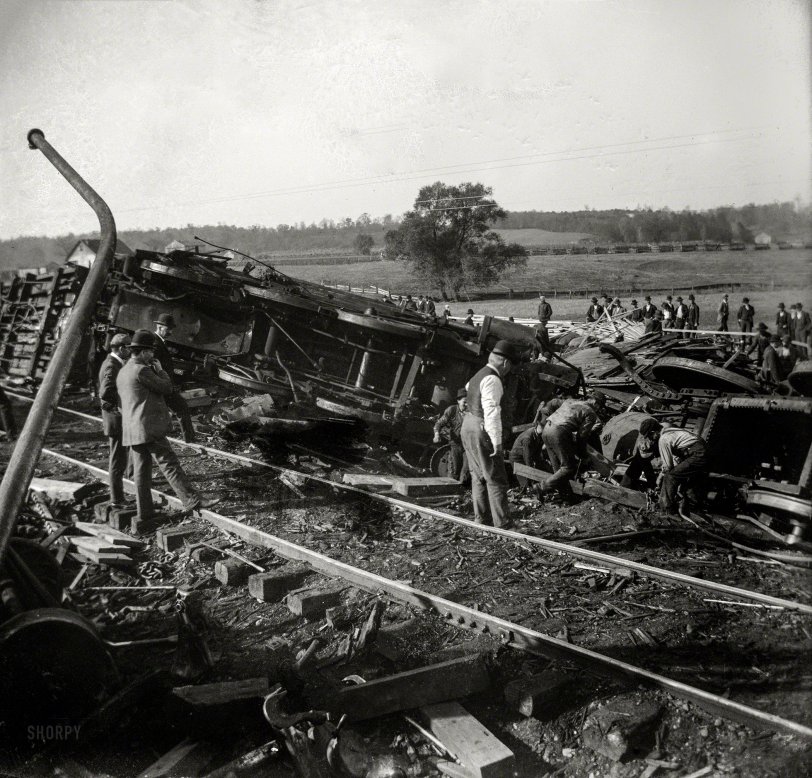


Framed or unframed, desk size to sofa size, printed by us in Arizona and Alabama since 2007. Explore now.
Shorpy is funded by you. Patreon contributors get an ad-free experience.
Learn more.

- Alas, hidden from view
- Exclusive pump
- Details, Details
- What's that building to the left of the tower?
- Coal Barges
- Bromo-Seltzer
- Inner harbor
- The Basin
- What a headache!
- Giant stepladder?
- Baldwin 62303
- Baldwin VO-1000
- Cold
- No expense spared
- Tough Guys
- Lost in Toyland
- And without gloves
- If I were a blindfolded time traveler
- Smoke Consumer Also Cooks
- Oh that stove!
- Possibly still there?
- What?!?
- $100 Reward
- Freeze Frame
- Texas Flyer wanted
- Just a Year Too Soon
- WWII -- Replacing men with women at the railroad crossing.
- Yes, Icing
- You kids drive me nuts!
- NOT An Easy Job
Print Emporium
Train Wreck: 1900

1897-1901. "Cincinnati, Hamilton & Dayton R.R. train wreck below Dayton, Ohio." 4x5 glass negative attributed to Wilbur and/or Orville Wright. View full size.
This is also true
While it is evident that the side rod on the upper side of the lead driver set was sheared off in the collision, the lower side shows no sign that anyone made any effort to remove the side rod nor the tire. Engines were, indeed, built with blind lead drivers.
A Line of ____
Upper right background, there is a line of objects giving the appearance of a string of box cars. Small cabins, maybe?
[Looks like a split-rail zigzag fence. -tterrace]
Monkey wrench
I also have a monkey wrench like the one that Alan spotted. It is all forged and machined. The adjuster has square threads and the wooden handles were hand fitted as well as if they were done by a gunsmith. Modern tools do not compare.
Front drivers were never blind
Only some very early rigid framed 4-4-0's of the mid 1800s experimented with using blind front drivers to negotiate sharper curves. It was not a practice continued on other locomotives as swinging pilot trucks would not keep a blind front driver on the rails.
On larger engines in the early 1900's blind center drivers were used but in following years better lateral motion devices and improved track geometry all but ended the practice. Once a locomotive was well wore in it was still possible to drop a blind center driver off the rails on a sharp curve and many locomotive rebuilds included putting flanged tires back on.
More than likely in this instance in the moments preceding the wreck the brakes were applied sufficiently to heat up the tires on the locomotive which expanded them and they have come off the wheels. As you can see the side rods have been removed and likely the loose tires from the front axle have been removed or broke during the wreck.
Is This Not Their Father's Wreck?
Isn't this the October 20, 1897 wreck between the southbound Toledo and Cincinnati Express, and the northbound freight 30 of the Cincinnati, Hamilton, and Dayton on board which was Bishop Milton Wright, the father of the famous Wright Brothers? See this.
Counterintuitive
Though not standard construction, quite a few 4-6-0 and 4-8-0 type engines, such as we are herein viewing from underneath, were built with blind leading drivers, as it was felt that the four wheel leading truck provided sufficient stability to obviate flanges on them, even at high speed.
Omitting this flange allowed the locomotive to better negotiate very sharp curves and turnouts at slow speed in yards and enginehouse areas.
Lack of this flanged driver was not a factor in this "head-on" collision. This was the result of a dispatching error or of misinterpretation by one of the engineers of the timetable or of the dispatchers instructions.
3 Things
There are three things I noticed. The blind drivers (no flanges) are on the leading drive axle. All the ones I've seen would have been on the center axle.
The monkey wrench laying next to the rail is identical to the one I have that came from The Milwaukee Road many decades ago.
The joint bolts in the rail have the nuts all on the same side. Standard practice now is to alternate sides. I assume the idea is to prevent them from all being sheared off by a derailed wheel. The bolt heads are a button type that a wheel would slide past without damage.
It's true
People DO love to stare at a train wreck.
























On Shorpy:
Today’s Top 5